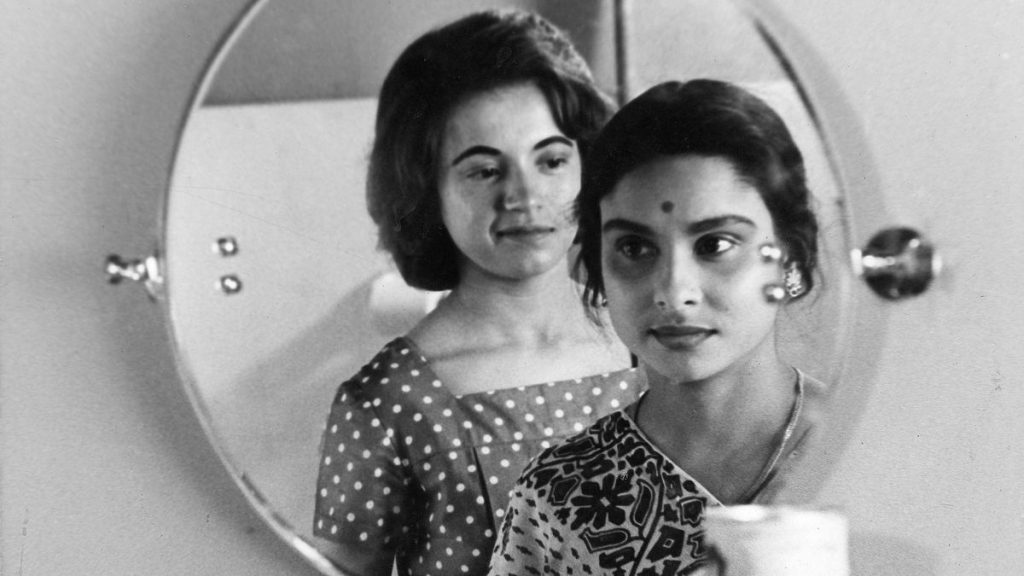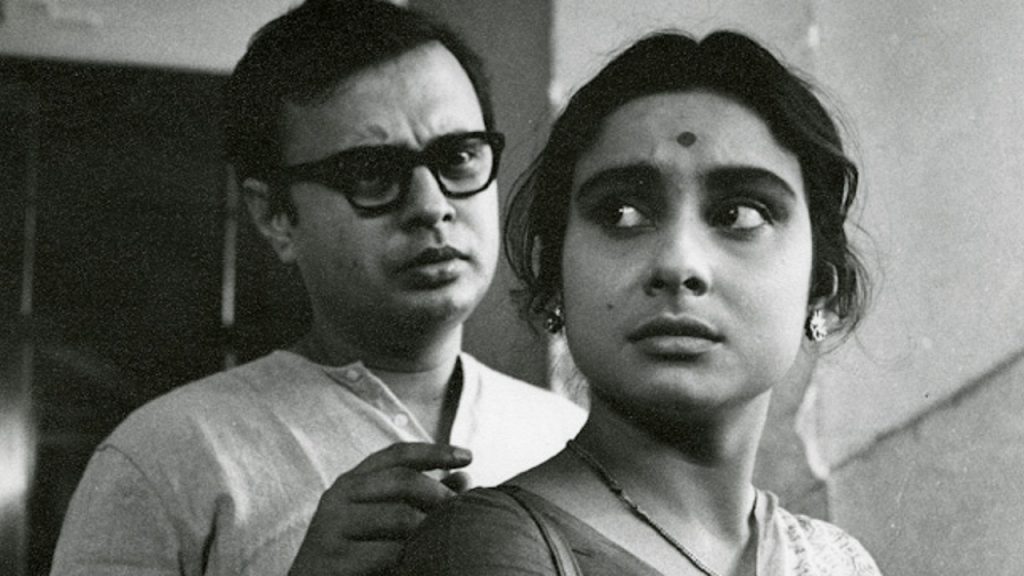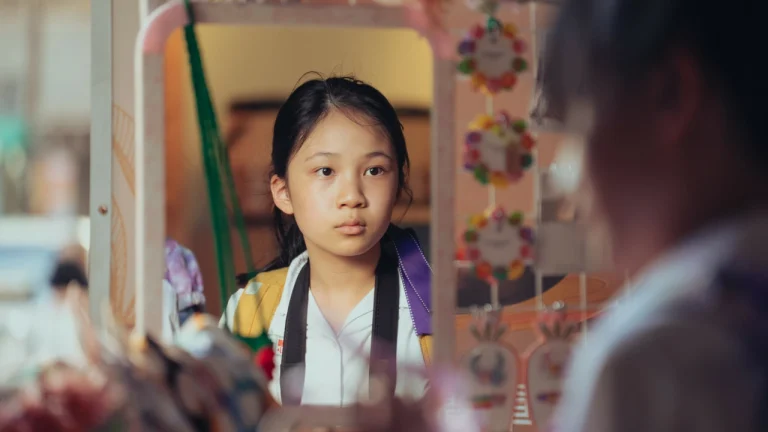Mahanagar (1963) (The Big City) is unarguably one of Ray’s finest creations. This film is based on ‘Abataranika,’ a short story by Narendranath Mitra. The narrative primarily illustrates how social relationships between the private and public spheres are maintained by ‘ideal’ housewives of Bengali middle-class families. In this film, Satyajit Ray presents a very strong female protagonist who plays a critical factor in social change. Ray’s symbolic portrayal of women in contemporary society can be identified as path-breaking.
The narrative very interestingly begins by portraying how in a Bengali middle-class family, the son, Subrata (played by Anil Chatterjee), who works in New Bharat Bank, is the only earning member. On one hand, while he has the responsibility of looking after the family’s economic standards, his wife Arati (played by Madhabi Mukherjee), the protagonist of Mahanagar (1963) (The Big City), attends the public sphere.
Similar to Mahanagar (1963) (The Big City): Satyajit Ray’s Pratidwandi
The father or patriarch of the family, Priyogopal (played by Haren Chatterjee), a retired school teacher, is a conservative. Mahanagar (1963) (The Big City) succinctly represents the conflicting ideologies between the two generations yet having common underlying patriarchal values of Bengali middle-class families.
While the head of the family unquestionably considers it unjust for his daughter-in-law to go ‘outside’ and work, Subrata is found to be in a dilemma in navigating his way through the values of being a ‘modern’ man or following his father’s path. He expresses his concern for his sister (played by Jaya Bhaduri), “What’s the use of studying? You will end up with kitchen duty like your sister-in-law here.” this necessarily expresses his disgust towards such values held by the stereotypical families.
In one of his conversations with Arati, he also mocks the conservative understanding of how a daughter-in-law in the family working outside or wearing ‘red lipstick’ is looked down upon by middle-class morality. However, as the narrative progresses, we sense a ‘change’ in him.
Due to their difficult economic condition, Arati decides to take up a job to share the family’s economic burden. While the job may appear as a ‘need’ of the hour, it is also important to highlight Satyajit Ray’s vision, which beautifully portrayed how desires intersect with needs in our everyday commitments.
However, none of the family members were happy with her commitment to work. It is essential in this regard to underline how her son, Pintu (played by Prasenjit Sarker), who is seven or eight years old, reacts to her decision. Such an instance of absence from his mother comes as a shock to him, and he expresses his anger. The depth of the scene where Arati expresses her melancholy of how things would have been easier for her if there had been no sense of objection clearly speculates the structural barriers faced by women after marriage with their work interests. Later in the narrative also, when Pintu falls ill, he blames his mother for going to work, saying, “Mother is bad.”.
This is illustrated in Mahanagar (1963) (The Big City), how conservative values are internalized and normalized among children from a very young age through socialization. On the other hand, he is immediately surprised to see his father not going to work for a few days. The entire confusion Arati faces, even while she goes to work on the first day, the back of her mind, indicates the understanding of how, in many instances, the capitalist patriarchal society expects women to prioritize ‘household’ (private) rather than ‘outside’ (public). The entire patriarchal construction of ‘motherhood’ and ‘child-rearing’ invisibilizes the importance of the responsibility of shared ‘parenthood’ in the private sphere.
In the narrative, Satyajit Ray beautifully presents various analogies. It is essential to highlight the scene where Arati compares the intensity of her cold hand between her marriage day and her first day of going to work, representing both as essential days in her life as it would mark the beginning of her new ‘identity’. In this narrative, it is essential to highlight how Ray has adhered to symbolism to convey his message to the audience. On the first day of her work, her interaction with her co-worker, Edith (played by Vicky Redhood), Arati showing her vermillion to communicate she is married, and Edith showing her ring to indicate that she is engaged can be viewed in two ways.
Recommended Read: Why Do We Love Movies?
On the one hand, it indicates the understanding of ‘bio-power’ and ‘bio-politics’ (Foucault 1982), how women’s bodies are marked to denote their relationship status following a sense of policing and exploitation. On the other hand, it would also symbolize how their identities are located regarding their private social relationships. The scene where Arati looks at the mirror after receiving her first wage symbolizes her accomplishment and glory in the public sphere. Her wearing lipstick every day only at work, gifted by Edith, can also be identified as a symbolic expression of her freedom from the private to the public sphere.
As argued above, Priyogopal has been exhibited as a fascinating character. His interpretation of ‘guru-dakshina’ is that he feels he has a particular form of claim he can make for his students. While justifying such understanding, he mentions the relationship between Dronacharya and Eklavya. His dialogue, ‘I am too old to change my views,’ addresses how typical middle-class values feel threatened by the sense of change. But later in his conversation with Arati where, he confronts his prejudice of holding on to conservative ideologies rather than accepting change, while he goes against those by speaking ill about his son to his students to achieve ‘guru-dakshina’ underlines the deception of existing values.
However, it is also important to address how Subrata felt a sense of threat from Arati working outside, leading him to ask her to leave work, and how he molded the excuse around the ‘family’ burden. But, there, we see very visibly how her desire to work outside ‘ghor’ (household) is getting subsumed as a result of the patriarchal middle-class family values. However, the narrative’s irony reflects Ray’s brilliance and how he managed to capture the hypocrisy of these values. While Subrata loses his job due to the shutting down of banks, he asks her not to leave the job. Still, by using a local phrase –“Stree’r push mash, Shamir shorbonaash”-, he reflects his uneasiness of her working, overlooking that the raise she demanded is because of the extreme condition of the family.
The scene where Edith goes on to demand commission from Mr.Mukherjee, the owner of the company where Arati works, remains relevant to date. It reflects how the feminist movement demanding an increase in the wage of women labour is still one of the most relevant concerns globally.
Related to Mahanagar (1963) (The Big City): Nayak: The Facade Behind Fame
Another interesting scene in the coffee shop where Arati describes Subrata’s occupation to her friend’s husband, even though he lost his job, reflects her urge to protect the honor of her husband and how, if her income is viewed as supplementary, she would still be accepted while her being the sole earner would be regarded problematic. It is also important to address here how patriarchal family values tend to put a major burden on the ‘son’ of the families by placing them on a pedestal of the efficient and ‘first-class’ earner of the family.
It is also significant to address Ray’s portrayal of minority communities, often stereotyped by those with social power. We can understand this from how Mr. Mukherjee fires Edith. The most significant part of the movie, in Arati’s confrontation with Mr. Mukherjee, questions the injustice against her co-worker, Edith. Despite her worse economic condition, she gives her resignation letter when Mr. Mukherjee refuses to apologize to Edith. This reflects how she chooses to prioritize her values and stands by right while, in many instances, we fail to do so, as agreed by Subrata, too, when he acknowledges and appreciates her courage.
But it also poses an important question to us as viewers: What values did Arati adhere to even though she is from a Bengali middle-class family? Or is it her experience in constant fighting against existing moralities that helped her break through the shackles?
The last scene with the dialogue by Subrata, ‘Let us try, I believe we both can,’ ends with uncertainty where we, as audiences, are unaware of what is waiting in fate for Arati and Subrata. But the sense of hope resides in our minds. In this complex big city, they both find courage and hope in the form of each other. Ray’s sheer brilliance lies in ending this film with uncertainties and yet filled with expectation that makes this film a landmark in the history of Indian cinema.






![Hum Do Hamaare Do [2021] Review: An Inert Bollywood Rom-Com with Messy Intentions](https://79468c92.delivery.rocketcdn.me/wp-content/uploads/2021/10/Hum-Do-Humare-Do-Movie-Review-768x432.jpg)
![The Big Sick [2017]: A Well Rounded and Deeply Felt Dramedy](https://79468c92.delivery.rocketcdn.me/wp-content/uploads/2017/09/big_sick_the_-_kazan_and_nanjiani-768x416.jpg)


